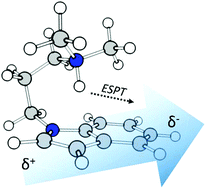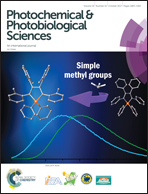Photophysics of N,N-dimethyl-3-(1-indolyl)propan-1-ammonium chloride and related derivatives†
Abstract
The photophysical properties of two new indole derivatives have been examined by steady-state and dynamic spectroscopic methods. The ground-state structures and conformations of 3-(1-indolyl)-N,N-dimethylpropan-1-ammonium chloride (InCl) and 3-(1-indolyl)-N,N,N-trimethylpropan-1-ammonium chloride (MeInCl) have been examined through density functional theory calculations. These calculations reveal a preference for a ‘closed’ conformation which places the cationic ammonium group in proximity to the π-electron cloud in low polarity environments. This interaction is best described as an intramolecular hydrogen–π bond in the case of InCl and a cation–π interaction for MeInCl. The ground-state conformational equilibria are influenced by changes in the dielectric constant of the solvent, resulting in a variety of photophysical behaviors. The excitation/emission spectra, fluorescence quantum yields, and excited-state lifetimes, are reported for InCl, MeInCl, and a reference compound, 1-methylindole, in 1,4-dioxane (ε = 2), acetonitrile (ε = 37), and water (ε = 78) where solubility allows. Data from these solvents provide evidence for independent fluorescence quenching pathways for InCl and MeInCl. In addition, they lead to insights into the complexities of indole photophysics by demonstrating the sensitivity of the locally-excited states to changes in charge-density and solvent environment.



 Please wait while we load your content...
Please wait while we load your content...